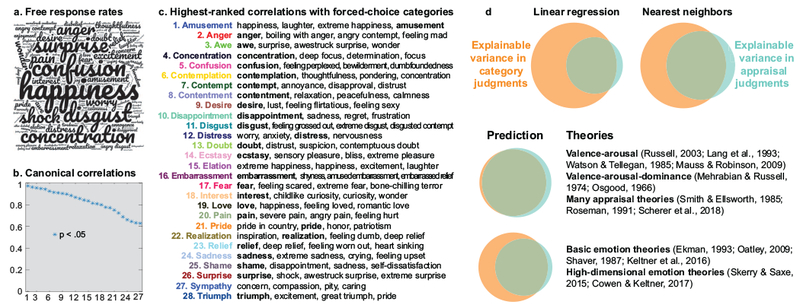Figure 1.

Comparing categorical to free-response and appraisal judgments: All 28 categories are reliable, distinct, and accurate descriptors of perceived emotion and cannot reduced to a small set of domain-general appraisals. (a) Relative usage rates of free-response terms. Font size is proportional to the number of times each term was used. Participants employed a rich array of terms. (b) Canonical correlations between categories and free response. All 27 dimensions of variance of the categorical judgments were recognized via free response (p <.05), indicating that the 28 categories are reliable, semantically distinct descriptors of emotional expression. (c) Free-response terms correlated with each forced-choice category. Correlations (r) were assessed between category judgments and free-response terms, across images. The free-response terms most highly correlated with each category consistently include the categories themselves and synonyms. (d) Proportion of variance explained in 28 categories by 13 affective scales and vice versa using linear and nonlinear regression. Affective scale judgments do not fully explain category judgments (39.9% and 56.1% of variance explained, Ordinary least squares [OLS] linear regression and k-nearest neighbors [kNN] regression, respectively), whereas category judgments do largely explain affective scales (91.4% and 87.1% of variance, OLS and kNN, respectively). Categories offer a richer conceptualization of emotion recognition. The smaller Venn diagrams illustrate results predicted by different theories. Our findings are consistent with theories that expressions convey emotion categories or are high dimensional and cannot be captured by 13 scales (Skerry & Saxe, 2015). See the online article for the color version of this figure.
